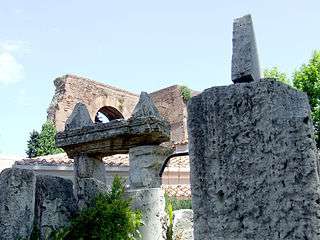List of basilicas in Ancient Rome
This is a list of the civil basilicas in ancient Rome.
List
- Built in 184 BC by Cato the Elder during his censorship, its remains were found on the north corner of the Roman Forum between the Curia and the Atrium Libertatis (the headquarters of the censors)[1]. The remains show reconstruction dating back to the age of Sulla. The Basilica became the centre of intense economic activity and its architectural form recalled the 'Egyptian Hall'.
- Built on the north-eastern side of the Roman Forum behind the tabernae veteres[2] by censor Tiberius Sempronius Gracchus in 170 BC.
- Founded in 121 A.C. on the north corner of the Roman Forum[3] by consul Lucius Opimius together with the reconstruction of the adjoining Temple of Concord. It was probably destroyed during the renovation of the temple under Tiberius.
- Basilica Fulvia
- Also known as Fulvia-Aemilia, it was built on the northeast side of the Roman Forum behind the tabernae novae argentariae by the censors in the year 179 BC, probably replacing a former basilica cited by Plautus. It was replaced in mid-1st century BC by the Basilica Aemilia.
- Basilica Aemilia or Basilica Paulli, situated on the north-eastern side of the Roman Forum[4], replaced the Basilica Fulvia or Fulvia-Aemilia behind the tabernae novae argentariae between 55 and 34 BC. It underwent various restorations until the 5th century.
- Built on the southwestern side of the Roman Forum[5] starting 55 BC, it replaced the Basilica Sempronia and the tabernae veteres. It was inaugurated in 46 BC, but damaged by fire in 12 BC. Having been restored and dedicated to the grandchildren of Augustus, Gaius and Lucius Caesar in 12 AD (Basilica Gai et Luci)it was destroyed by fire in 283, and once again restored by Diocletian.
- Mentioned in late sources, it has been identified by the two-aisled portico on pillars located on the left side of the Temple of Venus Genetrix in the Forum of Caesar[6] and pertinent to the renovation of the complex under Trajan.
- The basilica closed the Trajan's Forum on its north-western side[7].
- Also known as Basilica Constantini or Basilica Nova, its construction began under Maxentius around 305 AD on the slopes of the Velian Hill towards the Roman Forum[8] and ended under Consantine I. Probably in the 4th century it was integrated with a porticoed entrance towards the Via Sacra and an apse in the central niche of the opposite wall.
Private Basilicas

Villa Celimontana, remains of the Basilica Hilariana: detail of a dolmen and a sacral memorial stone. In the background, the Arcus Neroniani.
- Basilica of Junius Bassus (basilica Iunii Bassi)
- Built by Junius Annius Bassus, consul in 331 AD, it is located on the Esquiline Hill[9] and consists of a room richly decorated with opus sectile. It was converted into a church by Pope Simplicius (468-483).
- Basilica Hilariana
- It is a small basilica on the Caelian Hill[10] and situated under the modern military hospital. It was built in the mid-2nd century at the behest of the margaritarius (pearl merchant) Manius Publicius Ilarius[11] and intended for the college of the dendrophores, a religious congregation linked to the cult of Magna Mater and Attis[12], in which Ilarius had the role of quinquennalis perpetuus[13]. The complex, modified in the 3rd century, was abandoned in the 7th, maybe following an earthquake in 618 AD. It was partially underground: twelve steps outlined with marble led to a vestibule with black and white mosaics, depicting an eye struck by a spear with a ring of birds and animals around it; a threshold depicting the footprint of two feet, one entering and one leaving, led to a room with a basin and the base of a statue dedicated to Ilarius[14].
Other basilicas mentioned in sources
- Basilica Antonarum Duarum
- Remembered in a burial inscription, it was probably a building dedicated by Antonia major and Antonia minor, the two daughters of Octavia, sister of Augustus, and by Mark Antony. A possible location has been proposed in the Forum of Augustus.
- Basilica Iulia Aquiliana
- It is remembered by Vitruvius as a long and narrow building, with vestibules (chalcidica) on the short sides. Its location is unknown: it could have been the name of the Basilica Julia at the time of Caesar.
- Basilica Marciana and Basilica Matidiae
- It is probably identifiable with the arcades that flanked the temple dedicated to Matidia in the Campus Martius[15].
- To be identified with the brick hall whose remains are preserved behind the Pantheon[16], dating back to the era of Hadrian[17]. The hall, connected to the Baths of Agrippa, had a cross vaulted roof and the walls articulated by columns with a frieze depicting dolphins and a rich marble covering. It was supposedly used for business deals.
Notes
- 41°53′35.95″N 12°29′5.35″E
- 41°53′30.99″N 12°29′5.02″E
- 41°53′34.95″N 12°29′3.51″E
- 41.892554°N 12.48623°E
- 41.891979°N 12.484884°E
- 41°53′38.74″N 12°29′3.88″E
- 41°53′44″N 12°29′4.46″E
- 41.891775°N 12.488446°E
- 41°53′51.73″N 12°30′0.50″E
- 41°53′8.92″N 12°29′48.89″E
- CIL VI, 641; CIL VI, 30973.
- Samuel Ball Platner, A Topographical Dictionary of Ancient Rome. Oxford: 1929, p. 80.
- Filippo Coarelli, «I monumenti dei culti orientali in Roma», in La soteriologia dei culti orientali nell'Impero romano, Brill Archive, 1982, ISBN 9789004065017, p. 34.
- «Basilica Hilariana», in Lawrence Richardson, Jr., A New Topographical Dictionary of Ancient Rome, JHU Press, 1992, ISBN 9780801843006, p. 52.
- On the (re)discovery of the temple of Matidia, see qui and, for its meaning Alberto Giudice, Roma in età adrianea: l'immagine dell'ideologia politica nella ricostruzione architettonica pages 228-229 and passim.
- 41°53′53.51″N 12°28′36.71″E
- 41°53′53.51″N 12°28′36.71″E
This article is issued from Wikipedia. The text is licensed under Creative Commons - Attribution - Sharealike. Additional terms may apply for the media files.